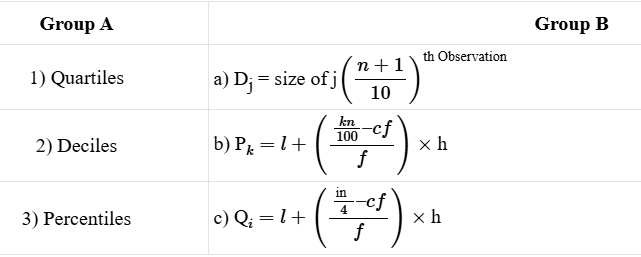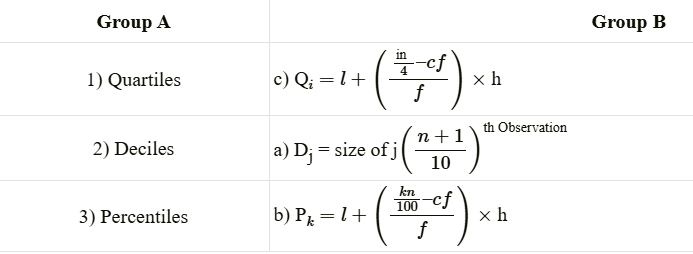Partition values
Exercise
Q. 1. Choose the correct option :
1) Statments that do not apply to Quartiles.
a) First arrange the values in ascending or descending order.
b) Observation can be divided into 4 parts.
c) They are represented as Q₁, Q₂, and Q₃.
d) Q₂ is also known as median.
Options:
1. a
2. a and b
3. a, b, and c
4. None of these
Answer: 4) None of these
Explanation: All statements (a, b, c, d) correctly apply to quartiles. Quartiles require data to be arranged in ascending or descending order, divide observations into 4 parts, are represented as Q₁, Q₂, Q₃, and Q₂ is the median.
2) Calculate D₇ from the given data:
Data: 4, 5, 6, 7, 8, 9, 10, 11, 12
Solution:
Arrange the data in ascending order: 4, 5, 6, 7, 8, 9, 10, 11, 12
n = 9 (number of observations)
For deciles, Dₖ = size of k (n + 1)/10 th observation
For D₇, k = 7:
D₇ = size of 7 (9 + 1)/10 th observation
= 7 × 10/10 = 7th observation
The 7th observation in the ordered data is 10.
Answer: D₇ = 10
Options:
1. 7
2. 9
3. 10
4. 12
Correct Option: 3) 10
3) Statements related to partition values that are correct:
a) Exact divisions of percentiles into 100 parts gives 99 points
b) Deciles have total 9 parts
c) Quartiles are shown by Q₁, Q₂, and Q₃
d) Symbolically, Percentiles and Deciles are shown by P and DOptions:
1. a and c
2. a and b
3. a, b, and c
4. a, c, and d
Answer: 4) a, c, and d
Explanation:
a) Correct. Percentiles divide data into 100 equal parts, resulting in 99 dividing points (P₁ to P₉₉).
b) Incorrect. Deciles divide data into 10 parts, so there are 9 dividing points (D₁ to D₉), not 9 parts.
c) Correct. Quartiles are denoted as Q₁, Q₂, and Q₃.
d) Correct. Percentiles are denoted by P and deciles by D.
Q.2 Identify the correct pairs from the given options:
Options:
1) 1-b, 2-c, 3-a
2) 1-c, 2-a, 3-b
3) 1-c, 2-b, 3-a
4) 1-a, 2-b, 3-c
Answer (b): 2) 1-c, 2-a, 3-b
Q.3. Give economic terms:
1. Procedure for dividing the data into equal parts.
2. Value that divides the series into ten equal parts.
3. Value that divides the whole set of observations into four equal parts.
Answers:
1. Partitioning
2. Decile
3. Quartile
Q.4. Solve the following:
1) Calculate Q₁, D₄, and P₂6 for the following
data: 18, 24, 45, 29, 4, 7, 28, 49, 16, 26, 25, 12, 10, 9, 8
Answers:
2) Calculate Q3, D₈, and P₃₅ for the given data.







Leave a Reply